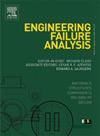Design and validation of an in-situ hydrogen embrittlement system in a rotary bending fatigue testing machine
IF 4.4
2区 工程技术
Q1 ENGINEERING, MECHANICAL
引用次数: 0
Abstract
Hydrogen is a promising clean energy source, but its integration brings challenges, notably hydrogen embrittlement (HE), which degrades materials used in hydrogen infrastructure. Metals, especially steel, are vulnerable, leading to reduced strength and safety risks. Testing methodologies, including in-situ and ex-situ methods, are crucial to understanding HE. In-situ methods simulate real-time exposure, whereas ex-situ methods focus on post-exposure effects. Rotary bending fatigue tests are particularly interesting as they are cost-effective fatigue machines. This study aims to design and implement an electrochemical cell for in-situ HE testing under cyclic loading in this particular fatigue machine.
The study focuses on adapting an electrochemical cell for a rotary bending fatigue machine, testing 42CrMo4 steel. Three key tasks were performed: (i) determining electrochemical parameters for inducing HE through Small Punch Tests (SPTs), (ii) evaluating an electrolyte jet system’s effectiveness, and (iii) designing and validating the electrochemical cell. Electrolytes tested included acid and alkaline solutions, and a novel jetting system was devised to ensure electrolyte coverage during high-speed rotation. The system’s electrical configuration and the cell’s structural adaptations for in-situ hydrogen charging were critical design elements.
The tests confirmed the system’s effectiveness in charging the specimen with hydrogen, as evidenced by fatigue life reduction and fracture surface analysis. Specimens precharged with hydrogen, specifically in acidic environments, displayed increased brittleness and premature failure, contrasting with the ductile behavior of non-embrittled specimens. This highlights the system’s potential for future studies on material resistance to hydrogen embrittlement under cyclic loads.
旋转弯曲疲劳试验机原位氢脆系统的设计与验证
氢是一种很有前途的清洁能源,但它的集成带来了挑战,特别是氢脆(HE),它会降解用于氢基础设施的材料。金属,特别是钢,是脆弱的,导致降低强度和安全风险。测试方法,包括原位和非原位方法,对于理解HE至关重要。原位方法模拟实时暴露,而非原位方法侧重于暴露后的影响。旋转弯曲疲劳试验特别有趣,因为它们是具有成本效益的疲劳试验机。本研究旨在设计和实现一个电化学电池,用于在这种特殊的疲劳试验机上进行循环载荷下的原位HE测试。将电化学电池应用于旋转弯曲疲劳试验机,对42CrMo4钢进行了测试。完成了三个关键任务:(i)通过小冲击测试(SPTs)确定诱导HE的电化学参数,(ii)评估电解质喷射系统的有效性,以及(iii)设计和验证电化学电池。测试的电解质包括酸性和碱性溶液,并设计了一种新型喷射系统,以确保在高速旋转过程中电解质的覆盖。系统的电气配置和电池的结构适应于原位充氢是关键的设计元素。试验证实了该系统在向试样充氢方面的有效性,疲劳寿命降低和断口分析证明了这一点。预充氢的试样,特别是在酸性环境中,与非脆化试样的延性行为相比,表现出脆性和过早破坏的增加。这突出了该系统在循环载荷下材料抗氢脆的未来研究中的潜力。
本文章由计算机程序翻译,如有差异,请以英文原文为准。
求助全文
约1分钟内获得全文
求助全文
来源期刊

Engineering Failure Analysis
工程技术-材料科学:表征与测试
CiteScore
7.70
自引率
20.00%
发文量
956
审稿时长
47 days
期刊介绍:
Engineering Failure Analysis publishes research papers describing the analysis of engineering failures and related studies.
Papers relating to the structure, properties and behaviour of engineering materials are encouraged, particularly those which also involve the detailed application of materials parameters to problems in engineering structures, components and design. In addition to the area of materials engineering, the interacting fields of mechanical, manufacturing, aeronautical, civil, chemical, corrosion and design engineering are considered relevant. Activity should be directed at analysing engineering failures and carrying out research to help reduce the incidences of failures and to extend the operating horizons of engineering materials.
Emphasis is placed on the mechanical properties of materials and their behaviour when influenced by structure, process and environment. Metallic, polymeric, ceramic and natural materials are all included and the application of these materials to real engineering situations should be emphasised. The use of a case-study based approach is also encouraged.
Engineering Failure Analysis provides essential reference material and critical feedback into the design process thereby contributing to the prevention of engineering failures in the future. All submissions will be subject to peer review from leading experts in the field.
 求助内容:
求助内容: 应助结果提醒方式:
应助结果提醒方式:


